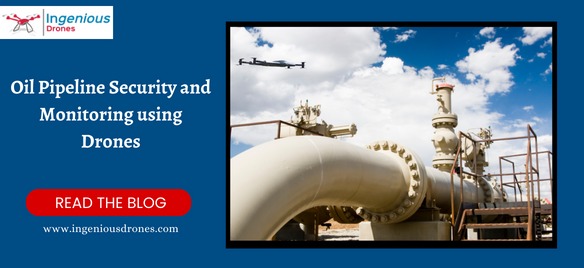Securing and monitoring oil pipelines is crucial for ensuring the safety, integrity, and efficiency of the infrastructure. Drones, also known as Unmanned Aerial Vehicles (UAVs) or Unmanned Aircraft Systems (UAS), can play a significant role in enhancing the security and monitoring of oil pipelines. Here are some ways drones can be utilized for oil pipeline security and monitoring:
- Surveillance and Patrols:
Drones equipped with high-resolution cameras and sensors can conduct regular aerial patrols along the length of the pipeline. They can monitor for any signs of physical damage, leaks, or unauthorized activities.
- Leak Detection:
Drones equipped with specialized sensors, such as infrared cameras or methane detectors, can be used to identify and locate potential leaks along the pipeline. The ability to quickly detect and respond to leaks is crucial for preventing environmental damage and ensuring the safety of nearby communities.
- Perimeter Security:
Drones can be used to monitor the perimeter of pipeline facilities, detecting and alerting security personnel to any breaches or suspicious activities. They can provide real-time video feeds and data to a central control centre for immediate response.
- Environmental Monitoring:
Drones can be equipped with environmental sensors to monitor air and water quality around the pipeline. This helps in assessing the impact of the pipeline on the surrounding ecosystem and facilitates early detection of any environmental issues.
- Geospatial Mapping:
Drones can create high-resolution, up-to-date maps of the pipeline route, which can be useful for planning and maintenance. These maps can also assist in identifying potential risks and optimizing the pipeline’s route for safety and efficiency.
- Incident Response:
In the event of a security incident or emergency, drones can quickly provide a real-time aerial view of the situation to aid emergency responders and security personnel. They can help assess the extent of the incident, guide response teams, and provide situational awareness.
- Remote Inspections:
Drones can conduct remote inspections of pipeline infrastructure, including elevated sections and hard-to-reach areas. This facilitates regular inspections without the need for extensive ground personnel or disruptive shutdowns.
- Communication Relay:
Drones can serve as communication relays, ensuring that communication is maintained in remote or challenging terrains. This is particularly valuable in emergency situations where maintaining communication is critical.
- Data Analytics and Automation:
The data collected by drones can be processed using analytics tools to identify patterns, trends, and potential issues. Automation tools can be integrated to trigger alerts and responses based on predefined criteria.
- Regulatory Compliance:
Drones can assist in meeting regulatory requirements by providing accurate and up-to-date documentation of pipeline conditions and security measures.
Implementing a comprehensive drone-based security and monitoring system for oil pipelines requires collaboration between oil companies, drone technology providers, and regulatory authorities. It’s important to ensure that the use of drones complies with relevant regulations and privacy considerations. Additionally, cybersecurity measures should be implemented to safeguard the data collected by drones and the communication channels used for control and monitoring. Ingenious Drones helps you with given the drones services for securing and monitoring your oil and gas pipelines area.


Recent Comments